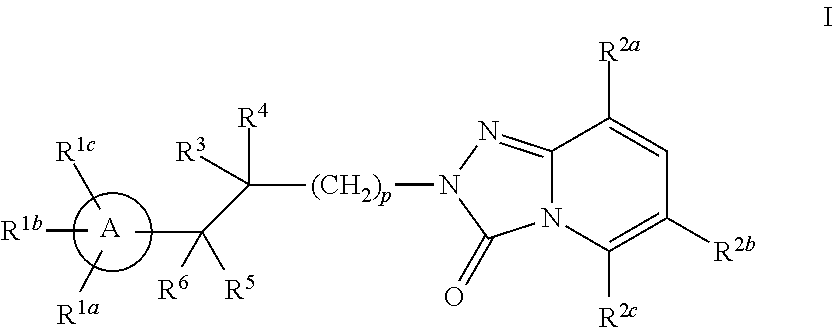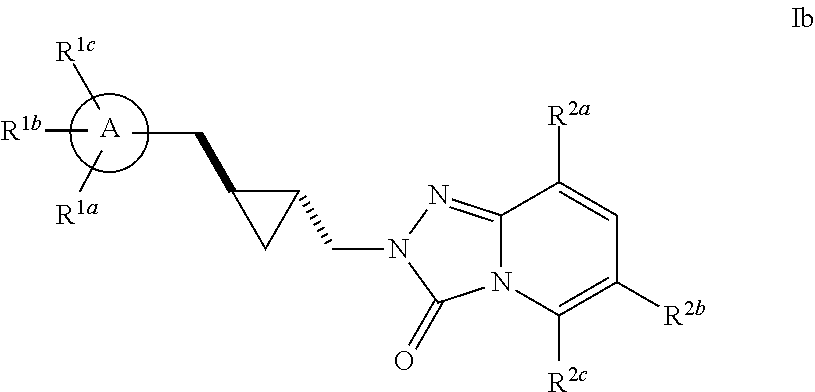Triazolopyridinone pde10 inhibitors
a technology of triazolopyridinone and inhibitors, applied in the field of compounds, can solve the problems of high non-compliance or discontinuation rate of medication, lack of efficacy, and dissatisfaction with therapy
- Summary
- Abstract
- Description
- Claims
- Application Information
AI Technical Summary
Benefits of technology
Problems solved by technology
Method used
Image
Examples
example 1
[0247]
2-vinylquinoline (1-2)
[0248]2-chloroquinoline (1-1) (1.00 g, 6.1 mmol) in toluene (25 mL) was sparged with N2 gas for 5 min, and tributyl(vinyl)stannane (2.52 g, 2.33 mL, 8.0 mmol) and tetrakis(triphenylphosphine)palladium (0.353 g, 0.31 mmol) were added. The mixture was heated at 125° C. for 1 h, then cooled and concentrated in vacuo. The residue was suspended in CH2Cl2 (20 mL) and purified by silica gel flash column chromatography (80 g cartridge), eluting with 0-30% EtOAc / hexanes over 20 min. The fractions containing the desired product (1-2) were pooled, and after solvent removal in vacuo, 700 mg (74%) of a clear oil were obtained. LC / MS: m / z (M+H)=156.0.
3-bromo-2-hydrazinylpyridine (1-4)
[0249]To 3-bromo-2-chloropyridine (1-3) (12.5 g, 65 mmol) in THF (100 mL) was added hydrazine (10.4 g, 10.2 mL, 325 mmol). The mixture was heated to reflux and stirred vigorously for 16 h. An additional portion of hydrazine (5.1 g, 5.0 mL, 159 mmol) was added and the reaction was heated fo...
example 2
[0252]
2-bromo-6-hydrazinylpyridine (2-2)
[0253]To a solution of 2-bromo-6-fluoropyridine (2-1) (1.0 g, 5.68 mmol) in THF (10 mL) was added hydrazine (0.91 g, 0.89 mL, 28.4 mmol). After stirring for 1 h room temperature, the mixture was heated at 65° C. for 1 h. The mixture was cooled, diluted with EtOAc (200 mL), washed with water (10 mL) and brine (10 mL), dried over MgSO4, filtered, and concentrated in vacuo. The resulting crude product (2-2) was used in the subsequent step without further purification. 1H NMR (300 MHz, CHCl3-d): δ 7.32 (app t, J=7.8 Hz, 1H), 6.82 (dd, J=7.8, 0.6 Hz, 1H), 6.67 (dd, J=7.8, 0.6 Hz, 1H), 5.93 (s, 1H), 3.80 (s, 2H).
5-bromo-[1,2,4]triazolo[4,3-a]pyridin-3(2H)-one (2-3)
[0254]To a solution of 2-2 (1.1 g, 5.85 mmol) in THF (50 mL) was added carbonyldiimidazole (1.14 g, 7.02 mmol), and the mixture was stirred for 1 h. The reaction was diluted with water (150 mL) and EtOAc (150 mL), causing a precipitate to form. The mixture was filtered through a sintered g...
example 3
[0256]
5-bromo-2-hydrazinylpyridine (3-2)
[0257]To 5-bromo-2-fluoropyridine (3-1) (46 g, 261 mmol) in THF (460 mL) was added hydrazine (41.9 g, 41.0 mL, 1.31 mol). The mixture was heated to reflux and stirred vigorously for 2 h. After cooling, the reaction mixture was diluted with water (200 mL) and extracted with EtOAc (3×500 mL). The combined organic layers were washed with brine, dried over MgSO4, filtered, and concentrated in vacuo. The resulting crude product (3-2) was used in the subsequent step without further purification. LC / MS: m / z (M+H)=187.9.
6-bromo-[1,2,4]triazolo[4,3-a]pyridin-3(2H)-one (3-3)
[0258]To a solution of 3-2 (2.0 g, 10.6 mmol) in dichloroethane (106 mL) was added triphosgene (3.16 g, 10.64 mmol). The reaction mixture was stirred at room temperature for 3 days. An off-white precipitate formed, which was washed with dichloroethane (100 mL) and dried in vacuo to give 2.03 g (89%) of 3-3 as a tan solid. LC / MS: m / z (M+H)=213.9.
6-bromo-2-(2-(quinolin-2-yl)ethyl)-[1,2...
PUM
| Property | Measurement | Unit |
|---|---|---|
| Pharmaceutically acceptable | aaaaa | aaaaa |
Abstract
Description
Claims
Application Information
 Login to View More
Login to View More - R&D
- Intellectual Property
- Life Sciences
- Materials
- Tech Scout
- Unparalleled Data Quality
- Higher Quality Content
- 60% Fewer Hallucinations
Browse by: Latest US Patents, China's latest patents, Technical Efficacy Thesaurus, Application Domain, Technology Topic, Popular Technical Reports.
© 2025 PatSnap. All rights reserved.Legal|Privacy policy|Modern Slavery Act Transparency Statement|Sitemap|About US| Contact US: help@patsnap.com



